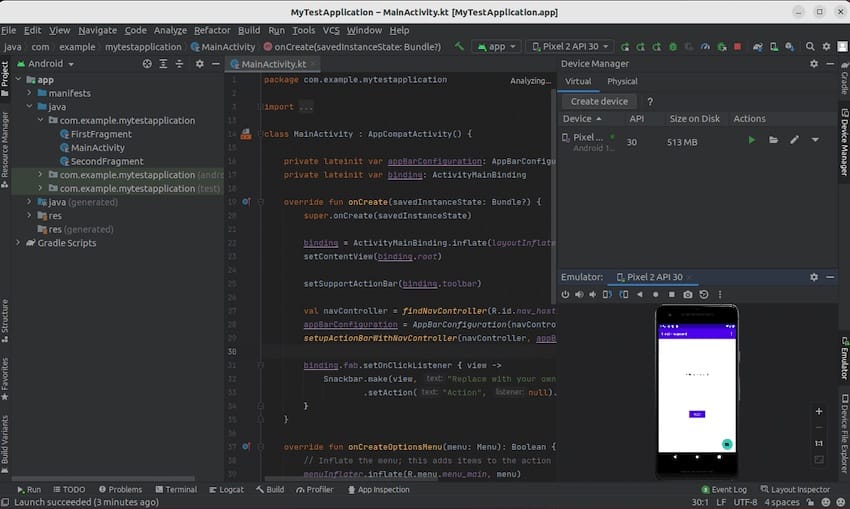How To Install Android Studio on Fedora 41

Android Studio stands as the official Integrated Development Environment (IDE) for Android app creation, offering a powerful toolkit for developers. For Linux enthusiasts running Fedora 41, setting up this robust development environment is a crucial step towards building innovative Android applications. This guide will walk you through the process of installing Android Studio on Fedora 41, ensuring you have a smooth setup experience.
Prerequisites for Installing Android Studio on Fedora 41
Before diving into the installation process, it’s essential to ensure your system meets the necessary requirements. Let’s break down what you’ll need to get started with Android Studio on Fedora 41.
System Requirements
Android Studio is a resource-intensive application, so your hardware should be up to the task. Here are the minimum and recommended specifications:
- RAM: At least 8 GB, though 16 GB or more is recommended for optimal performance.
- Disk Space: A minimum of 8 GB free space, preferably on an SSD for faster build times and overall responsiveness.
- Screen Resolution: 1280×800 minimum, but 1920×1080 or higher is recommended for a better development experience.
- Processor: A multi-core CPU with support for virtualization technology (Intel VT-x or AMD-V) for running Android emulators efficiently.
Fedora 41 supports various desktop environments, with GNOME and KDE being the most popular. Android Studio should work well on any of these, but ensure your chosen environment is stable and up-to-date.
Software Requirements
On the software side, you’ll need:
- Fedora 41 installed and fully updated
- GNU C Library (glibc) version 2.31 or later
- Java Development Kit (JDK) – OpenJDK or Oracle JDK (version 11 or later recommended)
With these prerequisites in place, you’re ready to begin the installation process.
Step-by-Step Guide to Installing Android Studio on Fedora 41
Follow these detailed steps to get Android Studio up and running on your Fedora 41 system.
Step 1: Update Your System
Before installing any new software, it’s crucial to ensure your system is up-to-date. Open a terminal and run the following command:
sudo dnf update -yThis command updates all installed packages to their latest versions, ensuring compatibility and security.
Step 2: Install Required Libraries
Android Studio requires several libraries to function correctly on Fedora. Install these dependencies by running:
sudo dnf install glibc.i686 glibc-devel.i686 libstdc++.i686 zlib-devel.i686 ncurses-devel.i686 libX11-devel.i686 libXrender.i686 libXrandr.i686These libraries provide necessary support for 32-bit applications, graphical interfaces, and development tools that Android Studio relies on.
Step 3: Download Android Studio
Visit the official Android Studio website to download the latest version. Alternatively, you can use the wget command in the terminal:
wget https://developer.android.com/studio -O android-studio.tar.gzThis command downloads the Android Studio package and saves it as “android-studio.tar.gz” in your current directory.
Step 4: Extract and Install Android Studio
Once the download is complete, extract the contents of the archive to the /opt directory:
sudo tar -xvzf android-studio.tar.gz -C /opt/This command extracts Android Studio to the /opt directory, which is commonly used for third-party applications.
Navigate to the installation directory:
cd /opt/android-studio/bin/Launch the Android Studio setup wizard:
./studio.shFollow the on-screen instructions to complete the initial setup. This process includes selecting your preferred UI theme, installing additional SDK components, and configuring emulator settings.
Step 5: Configure Environment Variables
To run Android Studio from any location in the terminal, add its bin directory to your PATH:
echo 'export PATH=$PATH:/opt/android-studio/bin' >> ~/.bashrc
source ~/.bashrcThis modification allows you to start Android Studio by simply typing “studio.sh” in the terminal.

Step 6: Install SDK Components
After the initial setup, use Android Studio’s SDK Manager to install essential components:
- Open Android Studio
- Go to “Tools” > “SDK Manager”
- In the “SDK Platforms” tab, select the Android versions you want to target
- Switch to the “SDK Tools” tab and ensure the following are installed:
- Android SDK Build-Tools
- Android Emulator
- Android SDK Platform-Tools
- Intel x86 Emulator Accelerator (HAXM installer) if you’re using an Intel processor
- Click “Apply” to download and install the selected components
Step 7: Create a Desktop Entry for Easy Access
To create a desktop shortcut for Android Studio, run:
/opt/android-studio/bin/studio.sh --create-desktop-entryThis command adds Android Studio to your application menu, making it easily accessible from your desktop environment.
Post-installation Setup and Optimization
After successfully installing Android Studio, there are several steps you can take to optimize your development environment.
Configuring JDK in Android Studio
Ensure Android Studio is using the correct JDK:
- Open Android Studio
- Go to “File” > “Project Structure”
- In the “JDK location” field, verify that the path points to your installed JDK
- If needed, click “New…” and navigate to your JDK installation directory
Using the correct JDK version ensures compatibility and optimal performance.
Setting Up Emulator or Physical Device Testing
To test your apps, you’ll need either an emulator or a physical Android device:
Emulator Setup:
- In Android Studio, go to “Tools” > “AVD Manager”
- Click “Create Virtual Device”
- Choose a device definition and select “Next”
- Select a system image (preferably with Google APIs) and click “Next”
- Configure the AVD options and click “Finish”
Physical Device Setup:
- Enable “Developer options” on your Android device
- Turn on “USB debugging” in the Developer options
- Connect your device to your computer via USB
- In Android Studio, your device should appear in the list of available devices
Optimizing Performance
To enhance Android Studio’s performance on Fedora 41:
- Allocate more RAM to Android Studio in the `
studio.vmoptions` file - Use an SSD for faster build times and improved responsiveness
- Enable Power Save Mode (File > Power Save Mode) when on battery or for less resource-intensive tasks
- Regularly clear caches and restart Android Studio to free up resources
Troubleshooting Common Issues During Installation
Even with careful preparation, you might encounter some issues. Here are solutions to common problems:
Issue: Missing Libraries
If you see errors about missing libraries, try installing additional dependencies:
sudo dnf install mesa-libGLU libXtst libXrender libXiIssue: Slow Performance
If Android Studio feels sluggish:
- Increase the memory allocation in the `
studio.vmoptions` file - Disable unused plugins (File > Settings > Plugins)
- Ensure your system has adequate free disk space
Issue: Emulator Not Starting
If the Android emulator fails to start:
- Check if virtualization is enabled in your BIOS settings
- Install KVM:
sudo dnf install @virtualization - Add your user to the KVM group:
sudo usermod -a -G kvm $USER
Congratulations! You have successfully installed Android Studio. Thanks for using this tutorial for installing Android Studio on Fedora 41 system. For additional help or useful information, we recommend you check the official Android Studio website.